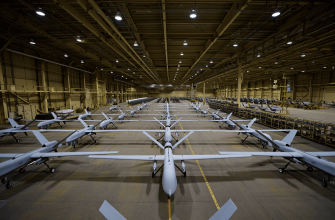
A celebration took place in Russian social networks the other day: an FPV drone controlled from Moscow hit an object in Chasovy Yar for the first time at an ultra-long range. In fact, it is not an ultra-long range: the drone “Gadfly” was launched as it should be at a distance of 11 kilometers from the target. But the control was taken by the operator in “Moscow City”.
The strike was made with the help of a new control system “Orbita”. The action itself was more in the style of marketing and advertising. As a serious operation it is much more difficult to imagine it.
At a time when developers and manufacturers of the “people’s military-industrial complex” are fighting for large orders (and large profits) of the Ministry of Defense, such actions are not surprising. Whoever came up with the move with the glass skyscraper in “Moscow City” made a blunder in an effort to draw attention to themselves – these panes of glass have already flown out from the strikes of Ukrainian drones. Therefore, the video and the news were quickly removed from the RIA Novosti website.
What’s interesting to us is this. UAV remote control technologies do not bring any discoveries. Back in the war with Saddam, U.S. Army operators conducted aerial surveillance from Nevada. Ukraine controls long-range UAVs via Starlink satellite communication terminals.
But this is the first time we’ve seen the control of an actually garage-built drone picked up hundreds of kilometers away, not from the position of a regular unit of the armed forces, but from a business center in Moscow. This is ideal for launching by an agent or using an “in the dark” intermediary. The developers of “Orbit” said that the new system will make it possible to launch drone strikes by issuing commands from anywhere in the world. Not a great merit, but a ready solution for terrorist organizations.
If a remote computer control interface is screwed to this miracle from the people’s garage, the operator will raise a drone on a 30 km long optical fiber to strike hundreds of kilometers away. Just today there were reports that they began to fly to Zaporozhye. It is worth thinking not only about today’s day. Especially since for real combat operations the trick demonstrated by the creators of “Orbit” (it can’t be called otherwise) gives practically nothing.









Great article! The pros and cons section was really helpful. I had no idea about the physical limitations of fiber optic cables on drones. Thanks for sharing!
The idea of garage-built drones being used in real combat is both inspiring and worrying. Innovation can come from anywhere these days!
Amazing how operators can control drones from a skyscraper in Moscow! The future of remote warfare is here, but I wonder how long until countermeasures catch up.
Fiber optics in drones? That’s next-level stealth. No radio signals, no jamming—just pure control. Curious to see how this changes military strategies.
This is a real game-changer for drone warfare! The use of fiber optic cables to bypass jamming is both clever and a bit scary. Technology is moving so fast on the battlefield.
Controlling a drone strike from the heart of Moscow City is wild! But isn’t it risky to operate from such a public place? Security must be a big concern.
This article really got me thinking about how technology, while advancing, often reveals more about human intentions than pure innovation. The idea that a drone can be controlled from a skyscraper far from the battlefield blurs lines between distance and proximity in warfare, making conflict feel both closer and more remote at the same time. It is fascinating yet unsettling to consider how tools designed for defense or surveillance can so easily be adapted into instruments of terror or subterfuge. In the end, perhaps the greatest challenge is not inventing new machines but understanding the ethical paths we choose when wielding them. After all, the technology itself does not decide our fate, but we do 🌍🤔
So basically, Moscow City went full tech ninja mode trying to impress everyone with garage drone strikes controlled from a skyscraper, only to have their shiny glass office take more hits than the drone. Meanwhile, the real innovation seems to be the idea that any random garage can slap together something remotely controlled thousands of kilometers away—sounds like the start of a new DIY hobby, just with a lot more exploding stuff. If terrorists start ordering drones like pizza deliveries, I hope they at least include a user manual and customer support.
The article raises important points about the symbolic nature of this drone strike demonstration and the real challenges behind effective long-range UAV operations. It highlights the gap between flashy marketing stunts and practical military capabilities, especially when considering control systems that could potentially be exploited by malicious actors. The concern about remote drone control from urban centers underlines how technology that seems impressive on the surface can have serious security implications if it falls into the wrong hands. The mention of fiber optics and satellite systems further emphasizes that while remote control is not new, integrating it into improvised platforms changes the threat landscape. Overall, this example stresses the need for careful evaluation of emerging technologies beyond their promotional value and the necessity to prepare for their possible misuse in modern conflicts.
This really highlights how quickly drone technology is evolving, but also how far it still has to go before being a game changer in serious combat situations. It’s fascinating but also a bit worrying to think about how easily this kind of tech could fall into the wrong hands. The idea of controlling drones from anywhere in the world definitely opens up new possibilities, but also new risks 🚁🌍.
This article raises some important points about how technological innovations in drone control can have unexpected implications beyond just military use. The idea of operating drones from any remote location, especially civilian urban centers, challenges traditional notions of warfare and security. It also highlights how advancements intended for defense could potentially be exploited by malicious actors, making the need for stronger regulations and safeguards even more critical. The commercialization aspect combined with the practical inefficiencies in real combat really puts into perspective the complex balance between innovation and realistic application. 🚀
This article raises important points about the gap between marketing hype and practical military applications, especially regarding drone technology. The ability to control a drone from a distant urban center may sound impressive, but as the article notes, the actual tactical value of such demonstrations can be limited. The mention of potential misuse by terrorist groups is a significant concern that highlights the double-edged nature of accessible drone control technologies. It seems that while the tech itself may not be groundbreaking, the way it is promoted and the implications for future conflicts deserve careful consideration.
This article really made me think about how technology can be used in ways we don’t always anticipate. The idea that a drone could be controlled from a business center hundreds of kilometers away is both impressive and a little scary. It shows how important it is to consider the implications of these advancements beyond just their technical capabilities. The concerns about misuse, especially by terrorist groups, feel very real and urgent. This isn’t just about military strategy anymore, but about global security and responsibility too. 🚁
Watching a garage-built drone get controlled from a fancy Moscow skyscraper feels like a high-tech episode of a spy comedy, but instead of sneaky gadgets, we get remote control drones and glass panes flying out of windows—can’t wait for the sequel where the drone needs a software update mid-flight 🤖
This really makes you think about how quickly technology can be adapted and misused in unexpected ways. The idea of controlling drones from a city skyscraper sounds like something out of a movie, but it also raises serious concerns about security and potential threats. It’s impressive and scary at the same time that simple, garage-built drones could be remotely operated from so far away, turning what seems like a hobbyist project into something with major implications for modern conflict. This development definitely pushes us to be more aware of how tech advancements can change the battlefield and our world. 🚁
This is honestly both impressive and a bit worrying at the same time 🤔🚀. The idea of controlling a drone from a skyscraper in Moscow sounds like something from a movie, but it also shows how technology is evolving in ways that might be used in unpredictable and possibly dangerous ways. It’s fascinating to see what can be done with so-called garage-built drones and new control systems, but it also raises questions about security and the future of warfare. The idea that anyone could potentially launch strikes from anywhere in the world is chilling 😬🌍. Definitely something that needs more attention beyond just the flashy demonstrations.
This whole situation feels like a mix of high-tech showmanship and worrying potential 🚁💻. The idea of controlling a drone from a skyscraper in Moscow sounds impressive until you realize how easily such tech could be misused by bad actors 🌍⚠️. It’s fascinating to see amateur-built drones getting this kind of remote control, but honestly, the concern about accessibility for terrorists is real. The future of warfare is definitely more digital and remote, but how do we balance innovation with safety? A lot to think about here!
This shows how drone technology is becoming more accessible and how control methods are evolving, but the real combat usefulness still seems limited. Interesting development though! 🚀
The way technology intertwines with modern conflict reveals much about the evolving nature of power and control. It feels like we’re witnessing a shift where the boundaries between frontlines and distant urban centers blur, making war not just a physical battle but a virtual contest of wills and ingenuity. This also raises profound questions about responsibility—when a drone strike can be commanded from a skyscraper, how do we trace accountability? The presence of such tools in the hands of unseen operators challenges our notions of warfare and ethics, reminding us that progress often comes with shadows. 🕊️🤔
Oh brilliant, a marketing stunt for a garage-built drone controlled from a glass skyscraper. Because that’s exactly what modern warfare needs: more ways for anonymous operators to play god from thousands of miles away. What a fantastic and totally not terrifying innovation for any future terrorist with an internet connection. Real proud moment. 🤦♀️🎯😬
Impressive tech 🚁 but the risks of remote drone control 🌍 open serious security concerns ⚠️ that can’t be ignored.
This showcase highlights how innovation can come from unexpected places, reminding us that the future of technology is shaped not just by large forces but by clever minds working quietly behind the scenes. Harnessing this potential responsibly could redefine how we approach challenges ahead 🚀